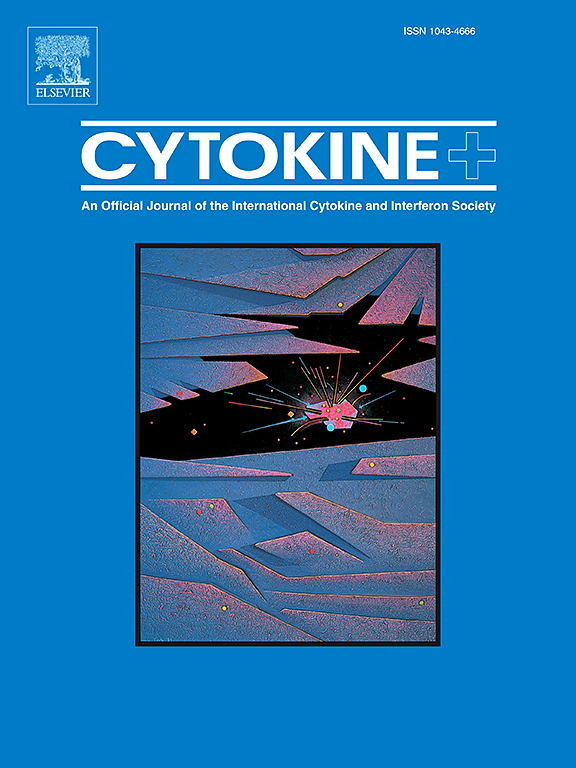Study on the correlation between intestinal flora and cytokines in children with Henoch-Schönlein purpura
IF 3.7
3区 医学
Q2 BIOCHEMISTRY & MOLECULAR BIOLOGY
引用次数: 0
Abstract
Background
The pathogenesis of Henoch-Schönlein purpura (HSP) is complex. It is currently believed that the development of HSP involves abnormalities in humoral immunity and cellular immunity. The intestinal microbiota has a powerful regulatory effect on the human immune system and has been shown to serve a significant role in the pathogenesis of various immune-mediated disorders. This study examines changes in intestinal flora and cytokines(IFN-γ, IL-4, IL-10, and IL-17) in children with HSP and explores their correlation, offering fresh insights for the prevention and treatment of HSP. METHODS: Blood and stool specimens were collected from 25 healthy children (control group) and 27 children with HSP (observation group). Enzyme-linked immunosorbent assay(ELISA) was used to detect the levels of cytokines IFN-γ, IL-4, IL-17, and IL-10 in the serum of all the study participants, and the 16S rRNA gene sequencing combined with high-throughput sequencing technology was used to analyze the intestinal flora of the study subjects. Finally, the correlation between serum cytokines and gut microbiota was analyzed in the children with HSP. RESULT:1)The serum levels of IL-4 and IL-17 in the observation group were higher than those in the control group, while the levels of IFN-γ and IL-10 were lower than those in the control group. 2) At the level of phylum, the abundance of Fusobacteria and Verrucomicrobia was higher than that in the control group, while the abundance of Firmicutes was lower than that of the control group, and the differences were statistically significant (P < 0.05); At the level of genus, the abundance of Prevotella and Akkermansia were higher than the control group, while the abundance of Bifidobacterium, Blautia, and Clostridium XlVa was lower than that in the control group, and the differences were all statistically significant (P < 0.05); At the species level, the abundance of Akkermansia muciniphila, Prevotella copri, and Subdoligranulum variabile was higher than that of the control group, while the abundance of Bifidobacterium pseudolongum, Brautella Weiss, and Bacteroides fragilis was lower than that in the control group, and the differences were statistically significant (P < 0.05). 3) The abundance of Blautia and Blautia wexlerae in the observation group was positively associated with the IL-10 level (r = 0.522, r = 0.578, P < 0.01). CONCLUSION: Disturbances in intestinal flora and changes in serum cytokines IFN-γ, IL-4, IL-10, and IL-17 were present in children with HSP. The abundance of Blautia and Blautia wexlerae in the gut microbiota of children with HSP was positively correlated with serum IL-10 levels.

Henoch-Schönlein紫癜患儿肠道菌群与细胞因子的相关性研究
背景Henoch-Schönlein紫癜(HSP)的发病机制复杂。目前认为热休克的发生与体液免疫和细胞免疫的异常有关。肠道微生物群对人体免疫系统具有强大的调节作用,并已被证明在各种免疫介导疾病的发病机制中起着重要作用。本研究通过对儿童热休克患者肠道菌群及细胞因子(IFN-γ、IL-4、IL-10、IL-17)变化的研究,探讨其相关性,为热休克的防治提供新的思路。方法:采集健康儿童25例(对照组)和热休克儿童27例(观察组)的血液和粪便标本。采用酶联免疫吸附法(ELISA)检测所有研究对象血清中IFN-γ、IL-4、IL-17、IL-10等细胞因子水平,采用16S rRNA基因测序结合高通量测序技术对研究对象肠道菌群进行分析。最后,分析HSP患儿血清细胞因子与肠道菌群的相关性。结果:1)观察组患者血清IL-4、IL-17水平高于对照组,IFN-γ、IL-10水平低于对照组。2)门水平上,Fusobacteria和Verrucomicrobia的丰度高于对照组,而Firmicutes的丰度低于对照组,差异均有统计学意义(P <;0.05);在属水平上,普氏菌(Prevotella)和Akkermansia丰度高于对照组,双歧杆菌(Bifidobacterium)、Blautia和Clostridium XlVa丰度低于对照组,差异均有统计学意义(P <;0.05);在物种水平上,粘毒阿克曼氏菌、copri普氏菌和亚多肽变异菌的丰度高于对照组,而假长双歧杆菌、魏氏勃氏菌和脆弱拟杆菌的丰度低于对照组,差异均有统计学意义(P <;0.05)。3)观察组蓝藻和幼蓝藻丰度与IL-10水平呈正相关(r = 0.522, r = 0.578, P <;0.01)。结论:热休克患儿存在肠道菌群紊乱和血清细胞因子IFN-γ、IL-4、IL-10、IL-17的变化。HSP患儿肠道菌群中Blautia和wautia的丰度与血清IL-10水平呈正相关。
本文章由计算机程序翻译,如有差异,请以英文原文为准。
求助全文
约1分钟内获得全文
求助全文
来源期刊

Cytokine
医学-免疫学
CiteScore
7.60
自引率
2.60%
发文量
262
审稿时长
48 days
期刊介绍:
The journal Cytokine has an open access mirror journal Cytokine: X, sharing the same aims and scope, editorial team, submission system and rigorous peer review.
* Devoted exclusively to the study of the molecular biology, genetics, biochemistry, immunology, genome-wide association studies, pathobiology, diagnostic and clinical applications of all known interleukins, hematopoietic factors, growth factors, cytotoxins, interferons, new cytokines, and chemokines, Cytokine provides comprehensive coverage of cytokines and their mechanisms of actions, 12 times a year by publishing original high quality refereed scientific papers from prominent investigators in both the academic and industrial sectors.
We will publish 3 major types of manuscripts:
1) Original manuscripts describing research results.
2) Basic and clinical reviews describing cytokine actions and regulation.
3) Short commentaries/perspectives on recently published aspects of cytokines, pathogenesis and clinical results.
 求助内容:
求助内容: 应助结果提醒方式:
应助结果提醒方式:


